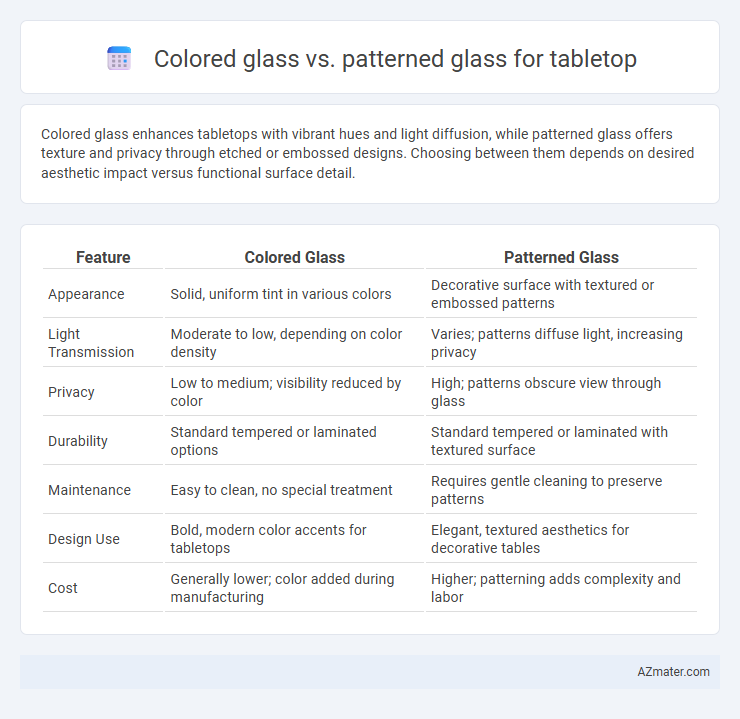Colored glass enhances tabletops with vibrant hues and light diffusion, while patterned glass offers texture and privacy through etched or embossed designs. Choosing between them depends on desired aesthetic impact versus functional surface detail.
Table of Comparison
| Feature | Colored Glass | Patterned Glass |
|---|---|---|
| Appearance | Solid, uniform tint in various colors | Decorative surface with textured or embossed patterns |
| Light Transmission | Moderate to low, depending on color density | Varies; patterns diffuse light, increasing privacy |
| Privacy | Low to medium; visibility reduced by color | High; patterns obscure view through glass |
| Durability | Standard tempered or laminated options | Standard tempered or laminated with textured surface |
| Maintenance | Easy to clean, no special treatment | Requires gentle cleaning to preserve patterns |
| Design Use | Bold, modern color accents for tabletops | Elegant, textured aesthetics for decorative tables |
| Cost | Generally lower; color added during manufacturing | Higher; patterning adds complexity and labor |
Introduction: Choosing the Right Glass for Your Tabletop
Colored glass enhances tabletops with vibrant hues and a modern aesthetic, offering UV-resistant options for durability and long-lasting color retention. Patterned glass provides texture and visual interest through etched, frosted, or embossed designs, adding privacy and concealing imperfections. Selecting between colored and patterned glass depends on desired style, maintenance ease, and functional needs like light diffusion or scratch resistance.
What is Colored Glass?
Colored glass for tabletops is created by adding metal oxides or minerals during the glass manufacturing process, resulting in vibrant hues integrated throughout the material. This type of glass offers consistent color and enhances aesthetic appeal while providing durability and resistance to UV fading. Unlike patterned glass, colored glass displays a uniform shade suitable for modern and sleek design themes.
What is Patterned Glass?
Patterned glass is a type of textured glass featuring embossed or engraved designs that add decorative appeal and diffuse light to enhance privacy without sacrificing brightness. Common patterns include rain, reed, and hammered effects, which create visual interest and obscure the view through the glass while maintaining transparency. In contrast to colored glass, patterned glass emphasizes surface texture rather than hue, making it ideal for tabletops where light diffusion and subtle aesthetics are desired.
Visual Appeal: Aesthetics Compared
Colored glass tabletops offer vibrant hues that enhance interior design by introducing bold color accents and modern sophistication. Patterned glass features intricate textures or designs that create depth and visual interest, lending artistic flair and uniqueness to furniture. Both options elevate aesthetics, with colored glass emphasizing rich tones while patterned glass highlights detailed craftsmanship.
Durability and Functionality
Colored glass tabletops offer enhanced durability due to tempering processes that resist scratches, stains, and heat, making them ideal for heavy daily use. Patterned glass, while visually dynamic and capable of hiding fingerprints and smudges, may be more prone to surface wear depending on the intricacy of the design and thickness of the glass. Both options maintain functional strength, but colored glass often provides a longer-lasting, low-maintenance surface suitable for various environments.
Maintenance and Cleaning Differences
Colored glass tabletops typically require gentle cleaning with a soft cloth and mild soap to prevent surface scratches and preserve vibrant hues, whereas patterned glass often features raised textures that can trap dust and grime, demanding more thorough scrubbing with a soft brush and non-abrasive cleaner. Colored glass is less prone to showing fingerprints and smudges compared to patterned glass, which may require frequent wipe-downs to maintain clarity and detail. Both types benefit from avoiding harsh chemicals and abrasive materials to protect their finishes and ensure longevity.
Light Transmission and Privacy
Colored glass for tabletops offers moderate light transmission, diffusing sunlight to create ambient warmth while maintaining some level of privacy. Patterned glass provides enhanced privacy due to its textured surface, which scatters light more effectively, reducing visibility through the tabletop. Both options balance aesthetics and functionality, with colored glass emphasizing visual vibrancy and patterned glass prioritizing obscured views.
Suitable Tabletop Applications
Colored glass enhances tabletop aesthetics in modern dining areas and artistic office spaces by offering vibrant hues and light-filtering effects. Patterned glass suits tabletops in traditional dining rooms, cafes, and conference tables, providing texture and privacy while masking fingerprints and scratches. Both materials serve functional decor roles, with colored glass prioritized for bold visual impact and patterned glass chosen for subtle elegance and durability.
Cost Comparison: Colored vs Patterned Glass
Colored glass for tabletops generally costs more due to the specialized pigments and uniform tinting processes required, often ranging from $50 to $150 per square foot. Patterned glass tends to be more affordable, with prices typically between $40 and $100 per square foot, as the designs are created through embossing or texturing techniques rather than color infusion. Both options vary in price based on thickness, customization, and brand, but patterned glass offers more budget-friendly choices for decorative tabletops.
Making Your Final Choice: Key Considerations
Choosing between colored glass and patterned glass for a tabletop depends on your aesthetic preferences and functional needs. Colored glass provides vibrant hues that can enhance room ambiance and coordinate with interior design, while patterned glass offers texture and privacy, diffusing light creatively. Consider durability, maintenance, and how each option complements your space when making your final decision.

Infographic: Colored glass vs Patterned glass for Tabletop
 azmater.com
azmater.com